2019 Can-Am Ryker Revealed
Entering the 3-wheeled market just got much easier: How does $8,499 sound?
Take a look at Can-Am’s all new Ryker. Announced late yesterday, it’s a pretty impressive machine with many interesting features, the most important of which is that it addresses the single biggest issue potential buyers of these 3-wheelers have always had: cost.
Since the launch of the first Spyder RS in 2008, those open to the idea of riding a non-leaner had to fork out a substantial chunk of change. Today, that chunk amounts to about 16 grand for the base F3, a number that blows up to about $27,000 if a top-of-the-line RT is the preferred choice. And these are reduced for 2019 MSRPs. 2018 models sold for even more.
The Ryker? $8,499. That’s where 2019 Ryker pricing starts, and obviously, it changes everything. Like, you could get two for the price of an F3 or three instead of a single RT Limited. However, selling Rykers two or three at a time isn’t the goal of the new machine at all. Selling one to someone who couldn’t afford a pricier Spyder, is. According to Senior Vice-President for Can-Am On-Road, Josée Perreault, that someone is very common:
“We know our customers. We know why they buy a Spyder and why they don’t. We know who they are, which demographics they belong to. And we especially know we have a massive growth opportunity. Our regular customer is 62 years old, on average. Sure, that’s high, but isn’t 60 the new 50? Seriously, that our average buyer’s age is on the high side doesn’t bother us at all. Actually, we’re embracing it. These are people who have both a comfortable amount of disposable income and time to enjoy life. They use their Spyders to travel, to be with their friends, to have fun, and they love ’em. Like, profoundly. They’re awesome customers, and we intend to keep taking care of them.
“On the other hand, we know there’s a substantial mass of potential that would love to own a Spyder but can’t. Our dealers keep telling us how they snap up a used unit as soon as one becomes available. We also know there are people out there wondering if they’d really like the riding experience or not. They’re uncertain. We know others just want a toy to occasionally play with. And we know there are young people who’d love to go ride, but can’t afford it. What’s common to all these groups is the desire for a price low enough to make it easy for them to make that decision and buy a 3-wheeler. You could say ‘easy’ is the entire goal of the Ryker: easy to buy, easy to operate.”
Listening to Perreault’s straight talk and no nonsense explanation, I couldn’t help but think of the incalculable number of times I heard motorcycle manufacturers speak similar words. In our industry, there hasn’t been a more used phrase in the past decade than: “We’re trying to reach new, younger customers.”
On top of the familiar speech, I had some skepticism about the whole slashing the price in two and three thing. I mean, what’s left when you go that far? All of which contributed to my surprise when I finally saw the new Ryker up close during a static sneak peek at Can-Am headquarters a few weeks ago. Looking at it for the first time, I was impressed at how young and hip its styling seemed compared to every Spyder I had seen so far, maybe with the exception of the sportier F3. From a distance, the Ryker looked airy and cool, even alien-ish from some angles. But it definitely didn’t look bland or cheap, which was a surprise. Still, I thought there must be a catch, so I got closer. The more I paid attention, the more I actually saw desirable characteristics, which is completely counterintuitive on a low-cost model. For example, I couldn’t keep my eyes off the humongous single-sided cast aluminum swing arm. It’s a completely exposed component that looks beefier than just about anything I’ve seen on a bike. And it’s definitely sexy, which was the weirdest part, since I was looking for cost-cutting evidence.
“Hold on a minute, I don’t see a belt or a chain??”
“No, there’s a drive shaft inside the swingarm.”
Wait, what? But even the two and three times more expensive Spyders don’t have a drive shaft… I was beginning to get confused, and it was just starting. I had the same reaction when I noticed the wheels were attached by a big single nut, à la Panigale.
“But… that shouldn’t be there. That’s exotic territory, not low cost.”
“Well, actually, it’s fewer parts, so less expensive.”
It was the weirdest thing, almost as if they didn’t realize what they had. I’ve always felt there was a somewhat of a disconnect between Can-Am people and the motorcycling world. They only seem to know and care about that world vaguely, certainly not as intensively as rival motorcycle companies know about each other’s products. They operate in a different universe where familiar stuff is ATVs, Side-by-Sides, snowmobiles and personal watercrafts – not to mention boats up to a few years ago. And even though their 3-wheelers exist alongside all of motorcycling, they don’t seem to be swayed one way or the other by what’s happening on two wheels.
A good example is the transmission chosen for the Ryker, a CVT, a technology very common to them. In the motorcycle world, it’s a scooter transmission (which is a dumb perception since CVTs are very close to being the best automatic solution so far on two wheels, but that’s another debate), but to them, it’s just the ideal twist-and-go solution needed on a model that is supposed to be as easy to operate as possible.
That ease-of-use priority had several other impacts on the Ryker, not the least of which is the starting procedure, or rather the fact that there isn’t any. To understand this, you need to know that for whatever reason, Spyders have always required a checklist just in order to start them: Press this first, accept that, press that second, then do it all over again if the ignition has been turned off. The same was true when engaging reverse, which you regularly do on these things. I always found the whole ritual profoundly annoying, hence my astonishment at the Ryker’s starting procedure: Turn the key, push start. Reverse? Just pull a lever on the left front side. Progress is wonderful, right? As for braking, as usual, it’s left to a pedal on the right side, which means a Ryker may be amongst the simplest powersports products to operate; a throttle to accelerate, one pedal to brake.
In terms of interesting features, as if the previous wasn’t enough, the Ryker keeps giving. For instance, it offers an adjustable riding position by way of an improved U-Fit system. Without tools and in a matter of seconds, both the handlebar and the pegs can be adjusted back and forth. As for storage, the big volumes of the Spyder family aren’t there, but there’s still a practical 7-liter compartment right above the engine. Speaking of engines, there are two choices, a 47-horsepower 600 cc parallel Twin and a 77-hp 900 Triple, both installed vertically and longitudinally. The entry-level $8,499 version is powered by the smaller motor, while choosing the bigger motor raises the price to $9,999. A passenger seat that also requires separate rear frame (about $600 total) is an option. The Ryker is also offered in a Rally Edition for $10,999.
The Ryker Rally Edition is also the first Can-Am 3-wheeler with off-road capability; it comes with the rear frame already installed, longer travel suspension (plus 1 inch), the 900 Triple, aggressively grooved tires, and a Rally riding mode that allows drifting the rear. All versions of the Ryker are equipped with Can-Am’s unique Vehicle Stability System which includes ABS and traction control. Standard warranty is one year instead of the two typically offered for the other models of the Spyder family. Finally, owners will be able to customize their ride’s look by switching body panels at relatively low cost and without tools.
Motorcycle.com will be testing the new Ryker shortly, so stay tuned.
The Ryker, Behind the Scenes
My sneak peak gave me access to several key people involved in the development of the Ryker, notably Senior Vice-President, Design, Innovation and Creative Services for BRP Denys Lapointe. He’s one of those guys that’s gold for interviews because he’s not afraid to talk and explain how the sausage is made, so I let him. We began our discussion with me simply asking how difficult it was to build a product so inexpensively.
“It’s really difficult to build a high-quality product at low cost. And I mean, really. It not only required all of our resources, but it also demanded we work differently. We went through a similar experience a few years ago when we built the Spark (the Spark is a Sea-Doo personal watercraft that sold for an almost unbelievable entry price of $4,999 when it was introduced). Our process is already very integrated for our regular products, but for Ryker, we had to push it way further. To explain it properly I have to go back to the beginning. We knew when we launched the first Spyder in ’08 that we were going to need a low-cost model. Remember what our original goal was: we wanted to democratize on-road riding. We hoped 3 wheels would have a similar effect on the world of 2 wheels as the sit-down personal watercraft had on the stand-up (Jet-Ski) market. We completely changed that market. All of a sudden, anyone could have fun on the water, not just the very skilled. We thought the same was possible with on-road riding. And we still do, but we quickly realized one of the main barriers of entry into the 3-wheel option we offered in 2008 was going to be pricing, so that’s when the low-cost project first began. And that’s also when we realized what a challenge it was going to be.
“Initially, we thought we could fit a smaller engine in a de-featured Spyder RS. We tried, but it just wasn’t working. What we were ending up with wasn’t satisfying us and cost was still much higher than what we were aiming for. It became clear that getting what we wanted would mean starting from a blank page. But at the time, our resources were already committed to the future products of the Spyder family and we just couldn’t get into another big project. We concentrated on the RT, the ST and the F3 models for about 6 or 7 years, so from about 2008 to 2014, and that’s when we went full steam ahead on the Ryker project.”
So, what was so tough about that concept specifically and in hindsight, was it a good thing you ended up pushing back the project a few years?
“Oh it was absolutely a good thing. We learned a lot with our Spyder family. Don’t forget we were in uncharted territory, and we actually kind of still are. There were no precedents, no one has offered products like ours before. So, everything we learned, we did as we went on. Over time, two barriers to our ultimate goal of democratizing on-road riding became very clear: pricing and ease of access. Spyders have sold well, but we were frankly hoping for more. We announced during our 10th anniversary last year that ‘more than 100,000 units’ had been sold so far. It was the first time we released an official number regarding Spyder sales, and like you, some mentioned it wasn’t bad at all. But that’s when you compare that to motorcycle sales numbers.
“We’re not uniquely in the motorcycle business. We know motorcyclists well, many are now our customers. But if we get back to the original intent of the 3-wheel idea, back to that wish of democratizing on-road riding, then we find that it (over 100,000) isn’t really a lot. Because we’re not just talking to the very small percentage of the population that already rides, we’re also looking at a much bigger pie – essentially, everyday people who have a driver’s license and are open to power sports. It’s with that perspective that we say we think much higher sales are attainable. And that’s how what we learned over the past decade with Spyder becomes so important. For example, we now know for a fact that if the price point was lower, a whole new category of buyers would entertain the idea of owning a Can-Am 3-wheeler.
“That information is the reason the Ryker exists. As for what was so difficult about building it towards the goal of an $8,499 MSRP, well, absolutely everything, starting with the way we usually build. When the end product’s retail price is relatively high, fewer questions have to be answered. Everyone still works together, of course, but designers can do their thing, engineers theirs, marketers theirs, etc. That structure doesn’t work with a very aggressive price point. If the product still has, say, a thousand parts, then that’s a thousand parts that have to be produced and paid for, and there’s just no way to cut costs enough to get to the end goal. You need to think differently and in a way you weren’t forced to do before.
“Fortunately, we had the Spark experience and we knew that. It basically comes down to a lower part count and a higher number of functions per part. Because many components are exposed, design must also be part of the equation. And to add to it all, we also had the goal of making the Ryker highly customizable by the average owner. It was a fascinating exercise that ended with some surprises. For example, we chose a single-nut wheel-locking system because it had a lower part count than the typical multi-nut system. But in the process, we ended up with something more desirable and very cool looking.
“That type of logic was applied to absolutely everything on the Ryker, even though it can’t always be seen. There’s one single big molded plastic part above the whole front end that holds together a high number of other parts, which saved a high number of brackets and fasteners. We even brought in suppliers and asked them to think in a new way so that they could build to a lower cost and with a higher number of functions per part. They came through. It really needed to be done that way, and it paid off. Our parts count is considerably smaller, and weight is down from about 900 lb for a Spyder to about 600 lb for a Ryker, so about a third less, too. That’s massive.
“All that being said, one thing we didn’t do was to forget the end goal. It’s easy, while cutting cost, to go too far, enough to change the nature of the product being created. For instance, the Ryker not only had to be affordable, but also had to be easy to operate even for someone completely new to power sports. A big part of that ease of use has to do with the transmission choice. We went with a CVT, a tranny we use in many of our products and one we know well. It wasn’t the cheapest choice, but the Ryker had to be a twist-and-go product. Having to deal with a clutch and gears would have helped to cut costs, but it would have contradicted the concept of a 3-wheeler anyone can understand how to operate in a matter of minutes. Which we knew the Ryker absolutely had to be.”
And yet, a low MSRP was only half the battle. The other was accessibility. One massive obstacle for new riders is getting their license. It’s a long and expensive process, and Can-Am says it knows for a fact it’s one of the major barriers motorcycling faces when it comes to attracting new people to the sport. Of course, extensive training is absolutely necessary before getting on the road with a 2-wheeler. But what about a non-leaning 3-wheeler, especially for someone who already has a driver’s license? Can-Am’s point of view is that you shouldn’t have to learn to ride a motorcycle in order to ride a 3-wheeler, and that if you already drive a car, then you should only need minimal training to hop on something with 3 wheels.
The Canadian brand isn’t just talking, but rather on a full-on mission to change the rules. Since 2010, their home province of Québec has been serving as the test bed for that change: Over there, if you only have a car license, a 7-hour training session is all you need before being legally allowed on the road with a 3-wheeler. As of this writing, according to Josée Perreault, Senior Vice-President for Can-Am On-Road, 39 states have already accepted the change in the US – and they’re going for all of them. Different states have different rules, but Perreault says the 3-wheel formation varies from a few hours at the minimum to four or five days, depending on the state.
Still, they didn’t stop there. Key to Can-Am’s easier accessibility plan are riding schools, since someone has to give that training. So, they created a new Rider Education Program and one by one, state by state, the brand is partnering with existing schools with the goal of making it as easy and as inexpensive as possible to ride a 3-wheeler. Smartly, they involved their dealers, who will loan Spyders and Rykers to local schools in the hope that those students will become new customers of those dealers.
And finally a personal take, if I may
The 3-wheel extension of the motorcycle industry is a strange case. On the one hand, hardcore motorcyclists still cringe at the very idea of a third wheel, and on the other, Can-Am people always seem uneasy about being associated with the world of motorcycles, this even though their entire premise is the democratization of riding. From where I’m standing, for all their differences, both the 2-wheel and 3-wheel sides of the industry have a lot in common, mainly getting new people to ride. They just go about it in very different ways, obviously. Personally, not only do I believe the Can-Am formula has real and strong growth potential, but I also think when it comes to attracting new blood to the sport, the Canadian brand is smarter and bolder than the motorcycle industry as a whole. Here’s why:
Ever since the financial crash, so for 10 years now, I’ve been on countless new model launches around the globe. I don’t know how many times I heard pitches about new models that were supposed to re-spark the industry by attracting new riders. Don’t even get me started on the hope that was and is still being put on hipsters. They just aren’t buying new motorcycles any more or less than non-bearded, non-inked and non-pierced humans, and I dare anyone to show me data saying otherwise.
My point is that for a decade now I’ve been told that this or that feature was going to crack the new rider enigma. None did. The best we’ve seen so far in terms of making it easier to ride a motorcycle is a DCT from Honda, a whole bunch of rider modes, combined brakes and recently an autoclutch from MV Agusta ( Turismo Veloce SCS). Am I forgetting something?
I test bikes for a living. I know full well they’re better built and easier to ride than ever. But after paying some attention to the grinding Can-Am is doing at all levels on its side, I have to say I feel the motorcycle industry could do more. Why is it so difficult to get a license? Why can’t you ride something with up to 125 cc when you already have a car license, as it’s common practice in Europe? Why is insurance so high in some places? Why hasn’t new technology been offered that really makes a motorcycle easier to operate for a beginner? Why are motorcycle seats still so high and why are their ergonomics essentially fixed? Why can’t a single motorcycle on Earth be offered with a simple twist-and-go CVT tranny? The technology is right there on scooters and ATVs and sleds, isn’t it? Why are women only 15 percent of motorcycle riders? Just saying, but over at Can-Am, 50 percent of buyers are women. Wouldn’t it be just a bit smart to really listen to what they have to say?
Bertrand Gahel is the editor and publisher of Le Guide de la Moto and a long-time friend of MO.
2019 Can-Am Ryker Specifications | ||
|---|---|---|
2019 Can-Am Ryker | 2019 Can-Am Ryker Rally | |
| Engine Type | Rotax 600 ACE: inline 2 cylinders, liquid-cooled with electronic fuel injection and electronic throttle control Rotax 900 ACE: inline 3 cylinders, liquid-cooled with electronic fuel injection and electronic throttle control | Rotax 900 ACE: inline 3 cylinders, liquid-cooled with electronic fuel injection and electronic throttle control |
| Bore & Stroke | 2.9 in. (74 mm) x 2.7 in. (69.7 mm) | 2.9 in. (74 mm) x 2.7 in. (69.7 mm) |
| Power | Rotax 600 ACE Engine: 47 hp (35 kW) at 7300 rpm (claimed) Rotax 900 ACE Engine: 77 hp (57.5 kW) at 7100 rpm (claimed) | Rotax 900 ACE Engine: 77 hp (57.5 kW) at 7100 rpm (claimed) |
| Torque | Rotax 600 ACE Engine: 35 ft-lb (47 Nm) at 6200 rpm (claimed) Rotax 900 ACE Engine: 56 ft-lb (76 Nm) at 6300 rpm (claimed) | Rotax 900 ACE Engine: 56 ft-lb (76 Nm) at 6300 rpm (claimed) |
| Transmission | Automatic (CVT) with reverse | Automatic (CVT) with reverse |
| Front Suspension | Double wishbone | |
| Front Shocks Type / Travel | Sachs twin-tube coil-over shocks / 5.39 in. (137 mm) | KYB HPG with preload adjustment 36mm / 6.38 in. (162 mm) |
| Rear Suspension | Multi-link – mono swing arm | Multi-link – mono swing arm |
| Rear Shock Type / Travel | SACHS Twin-tube coil-over shocks with preload adjustment / 5.91 in. (150 mm) | KYB HPG 40 mm with remote reservoir 4-positions compression adjustable damping and preload adjustement / 6.89 in. (175 mm) |
| Front Brakes | 270 mm discs with Nissin 2-piston floating calipers | 270 mm discs with Nissin 2-piston floating calipers |
| Rear Brake | 220 mm disc, 1-piston floating caliper | 220 mm disc, 1-piston floating caliper |
| Parking Brake | Park lock | Park lock |
| Front Tires | MC145/60R16 66T | MC145/60R16 66T |
| Rear Tire | MC205/45R16 77T | MC205/55R15 81T |
| Aluminum Front Rims | 5-spoke Carbon black, 16 x 4.5 in. (406 x 114 mm) | 5-spoke Carbon black & Machined, 16 x 4.5 in. (406 x 114 mm) |
| Aluminum Rear Rim | 5-spoke Carbon black, 16 x 6.5 in. (406 x 165 mm) | 5-spoke Carbon black & Machined, 15 x 6.5 in. (381 x 165 mm) |
| Storage Capacity | 1.85 gal (7 L) | 1.85 gal (7 L) |
| Fuel Capacity | 5.28 gal (20 L) | 5.28 gal (20 L) |
| Fuel Type | Premium unleaded | |
| L x W x H | 92.6 x 59.4 x 41.8 in. (2,352 x 1,509 x 1,062 mm) | 92.6 x 59.4 x 41.8 in. (2,352 x 1,509 x 1,062 mm) |
| Wheelbase | 67.3 in. (1,709 mm) | 67.3 in. (1,709 mm) |
| Seat Height | Rotax 600 ACE Engine: 23.6 in. (599 mm) Rotax 900 ACE Engine: 23.5 in. (597 mm) | 24.2 in. (615 mm) |
| Ground Clearance | Rotax 600 ACE Engine: 4.1 in. (104 mm) Rotax 900 ACE Engine: 4.0 in. (102 mm) | 4.4 in. (112 mm) |
| Dry Weight | Rotax 600 ACE Engine: 594 lb (270 kg) Rotax 900 ACE Engine: 616 lb (280 kg) | 627 lb (285 kg) |
| Type | 4.5″ digital display | 4.5″ digital display |
| Main Functions | Rotax 600 ACE Engine: Speedometer, tachometer, odometer, trips, gear position, distance to empty, engine lights, fuel gauge, clock, ECO mode Rotax 900 ACE Engine: Speedometer, tachometer, odometer, trips, gear position, distance to empty, engine lights, fuel gauge, clock, ECO mode and Sport mode | Speedometer, tachometer, odometer, trips, gear position, distance to empty, engine lights, fuel gauge, clock, ECO mode, Sport mode and Rally mode. |
| Electronics | Stability Control System Traction Control System Anti-lock Braking System Anti-theft Digitally Encoded Security System Hill Hold Control | Stability Control System Traction Control System Anti-lock Braking System Anti-theft Digitally Encoded Security System Hill Hold Control |
| Factory | 1-year BRP Limited Warranty with 1-year roadside assistance BRP’s B.E.S.T. extended service term available from 12 to 36 months | 1-year BRP Limited Warranty with 1-year roadside assistance BRP’s B.E.S.T. extended service term available from 12 to 36 months |
More by Bertrand Gahel




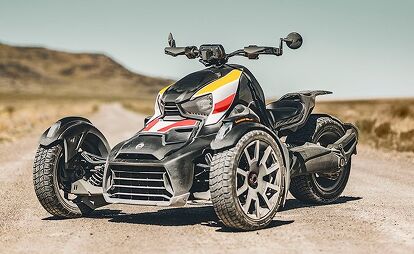




























































































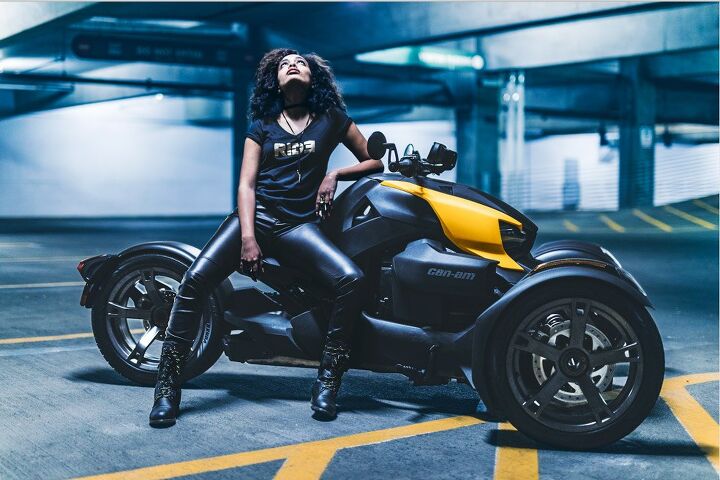





















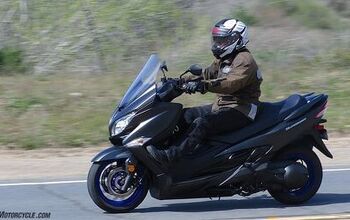


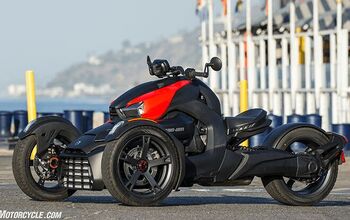

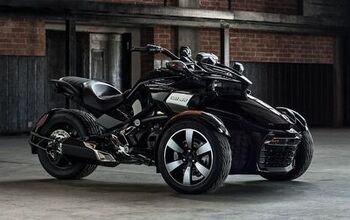


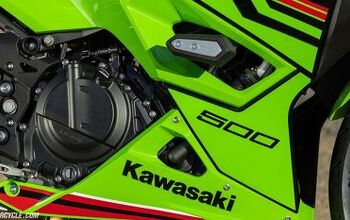








Comments
Join the conversation
Was pretty hot and bothered until I got to the CVT part. Then the stiffness completely went away.
I get that they are trying to reach people who are unable to operate a clutch and that is fine, but the CVT lets me out of the picture. A pity too, as I was wondering what one of these would be like in snow - LOL
I think this will be a winner for CanAm. I rode the previous generation machines, and while I didn't want to buy one, I really enjoyed riding them. The sporting model, coupled with the paddle shifter, was the one I liked best. Now, with much more competitive pricing, CV transmission, a huge weight loss, and shaft drive, this one will be much more attractive, especially to non motorcycle riders. I think this might bring plenty of people to the joys of riding, with a significantly lower intimidation factor than conventional motorcycles. That's a very good thing for all of us. More riders means more awareness, more dealers, sales, etc. this might even be the thing that keeps some shops open. The off road one is obviously not for serious off-road work, but would be an absolute hoot on dirt roads!